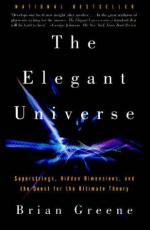
|
| Name: _________________________ | Period: ___________________ |
This quiz consists of 5 multiple choice and 5 short answer questions through Chapter 5, The Need for a New Theory, General Relativity vs. Quantum Mechanics.
Multiple Choice Questions
1. Who discovered the theory of general relativity?
(a) Max Planck.
(b) Richard Feynman.
(c) Albert Einstein.
(d) Isaac Newton.
2. What is the result when a particle of matter and a particle of antimatter are brought into contact?
(a) A strange quark is formed.
(b) A black hole is formed.
(c) Energy is released and both particles are destroyed.
(d) A theoretically unlimited amount of energy is released.
3. General relativity is incompatible with _____.
(a) The big bang theory.
(b) The photoelectric effect.
(c) Quantum mechanics.
(d) State theory.
4. What is the photoelectric effect?
(a) Electrons follow quantum paths made by photons.
(b) Photons can spontaneously decay into electrons in powerful magnetic fields.
(c) Electrons and photons only interact if they have the same frequency.
(d) When light shines on metals, the metals emit electrons.
5. Richard Feynman's "sum over paths" theory states that in the double-slit experiment, an electron behaves in what way?
(a) It follows the same path every time.
(b) The sum of all possible frequencies describes the frequency of the final path taken.
(c) It follows all possible paths at the same time.
(d) It follows a unique path every time.
Short Answer Questions
1. In 1968 it was discovered that protons and neutrons are composed of which type of particle?
2. Why are the fluctuations that quantum physics predicts not observable in everyday life?
3. What is the fundamental particle, the smallest possible bundle of energy, for the electromagnetic force?
4. Quantum physics began with the study of the energy inside a heated, closed container, such as an oven. The problem with theories at the time was that they predicted that _____.
5. What is quantum foam?
|
This section contains 363 words (approx. 2 pages at 300 words per page) |

|




